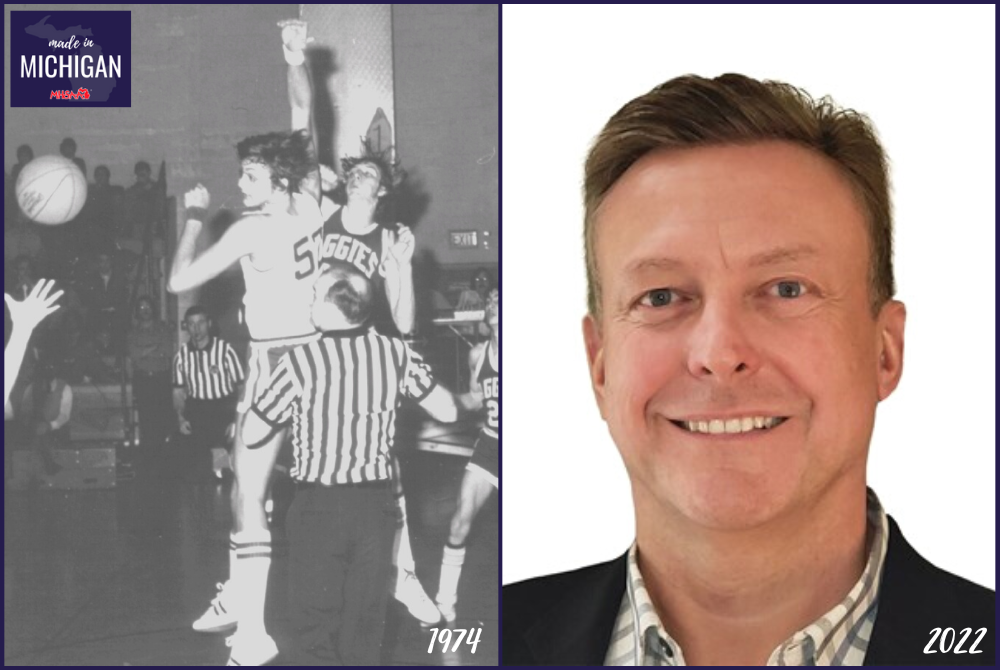
Championship Memories Still Resonate with St. Thomas Star Lillard
By
Doug Donnelly
Special for MHSAA.com
July 21, 2022
It took about four decades, but a couple of years ago, Len Lillard finally got to watch the 1974 Class D Boys Basketball Final.
The outcome, of course, was the same as when Lillard, a star 6-foot-7 center from Ann Arbor St. Thomas, dominated the game and led the Irish to the championship that March. But it was just as fun to watch it once more.
“It was great fun to watch,” Lillard said. “It was interesting, to say the least.”
Lillard had a sensational athletic career at St. Thomas, now known as Father Gabriel Richard. Not only was he an outstanding basketball player, but he also won Lower Peninsula Class D Finals high jump and shot put championships.
He earned a scholarship to the University of Michigan and played four years for the Wolverines, including the season they made it to the Final Four and faced undefeated and eventual national champion Indiana.
“Their top seven guys played professionally,” Lillard recalled. “That team was outstanding.”
Today, 50 years later, Lillard is a successful investment banker living just outside of Chicago. He hasn’t lived in Michigan since 1987, but still has close ties to teammates from the University of Michigan – and St. Thomas. He plans this month, in fact, to attend a Michigan basketball alumni function in Ann Arbor.
“We stay in touch,” he said.
Lillard said playing for the Michigan Wolverines opened a lot of doors for him professionally.
“It was a very good ice-breaker,” he said. “In the financial world I was in, you had to talk to people about tens of millions, sometimes hundreds of millions of dollars in investments. You have to prove yourself and be competent very quickly. But, the basketball, the Final Four … it was a good conversation starter.”
Lillard was part of an outstanding group of athletes that happened to attend St. Thomas during the same time frame.
“I think it was a case of the stars lining up,” Lillard said. “It was just a couple of really good classes that happened to be at the same school at the same time.”
St. Thomas moved from the Catholic High School League to the Tri-County Conference when Lillard was a senior. The TCC was a new conference and, ultimately, offered little competition for the Irish in almost any sport.
St. Thomas was heads and shoulders better than the rest of the league and easily went 10-0 to claim the first boys basketball league title under coach Mike Ramker. Lillard averaged 23.6 points a game in league play. In one of the most dominating performances in league history, Lillard scored 42 points and pulled down 31 rebounds in a win over Whitmore Lake.
In the Class D Semifinals he scored 31 points and had 13 rebounds. In the 68-53 win over Harbor Springs to clinch the title, Lillard scored 18 points and added 18 rebounds and six blocked shots.
Word around the MHSAA Tournament was Lillard was headed to Notre Dame. Instead, he accepted a scholarship from Michigan, which was located just a couple miles from the gym where St. Thomas played.
“He was a tremendous athlete for his time,” Ramker said.
Lillard was a member of the 1975-76 University of Michigan men’s basketball team that played in the Final Four and was defeated in the national championship game by the undefeated Indiana Hoosiers.
“It was a great experience,” said Lillard. “Our basketball fans, and some football fans as well, were very excited and a lot of them made the trip to Philadelphia, so we had a loud cheering section.”
The Final Four was a bit different during that era, but it still was a big deal.
“This was pre-ESPN, so there was not hourly coverage, but even though players and coaches try to be low key, it was a big deal to make it to the finals,” Lillard said.
Lillard could have gone to a smaller school and received more playing time, or perhaps another Big Ten school. Getting an education from the University of Michigan, however, was worth it. Lillard said making the transition from Class D to Division I college basketball wasn’t easy.
“It was difficult. I knew the competition would be much harder which it was, but there were other issues that I was not as prepared for,” he said. “At the end of the day, I was not going to play professional basketball, and playing for a highly-ranked University of Michigan team and earning a degree from Michigan was a great accomplishment.”
Lillard appeared in five games in 1975-76. He came back to the Wolverines in 1976-77 and appeared in 11 games, making 8 of his 12 field goal attempts, both of his free throws and pulling down 14 rebounds. Coached by Johnny Orr, the Wolverines were ranked No. 1 in the country, won the Big Ten championship and advanced to the Elite 8.
Lillard graduated from Michigan in 1978 and joined his family’s contracting business. At the same time, he started night school in pursuit of a Master of Business Administration degree. He got married and moved away from the Ann Arbor area.
He has more than 30 years of experience working in finance and capital markets as part of such well-respected firms as Merit Capital Partners, Banc One Capital Partners and The Prudential Capital Group. Today, at 66, he is managing partner with Glaucon Capital Partners.
He and his wife Karen raised three sons, now aged 29, 26 and 24. The middle child, Grant, was Big Ten Freshman of the Year and Defensive Player of the Year while playing soccer at the University of Indiana. He now plays professionally in Major League Soccer.
“He was a much better athlete than me,” Lillard said.
Basketball and sports in Michigan are never too far from Lillard’s mind. He checks in with old teammates on occasion and once had coffee with an opponent who he battled in the Final from Harbor Springs who was a sheriff in a town where he vacationed.
“He was a great guy,” Lillard said. “We had a lot of fun with it.”
It was a former St. Thomas teammate who rediscovered the film of the championship game. He had the film converted to a DVD and gave copies to team members. Those Finals were played at Jenison Field House at Michigan State University – one of several interesting places St. Thomas played at during Lillard’s career.
“Some of my fondest memories are playing in some of the old Catholic League gymnasiums,” Lillard said. “Some of the second-floor gyms with a running track around them were so amazing, such tiny little gyms. Some of them had clocks that still wound. You never really knew how much time was left in the quarter. We had some great times, that’s for sure.”
2021-22 Made in Michigan
July 14: Portage Central Champ Rolls to Vanderbilt, Writing Next Chapter in Alabama - Read
July 12: Coaching Couple Passing On Knowledge, Providing Opportunities for Frankfort Wrestlers - Read
June 30: Hrynewich's Star Continuing to Rise with Olympic, Pro Sports Arrivals - Read
PHOTOS (Top) At left, Len Lillard as the standout on the Ann Arbor St. Thomas boys basketball team in 1974; at right, Lillard today as a father of three and successful investment banker. (Action photo courtesy of Doug Donnelly, current photo courtesy of Glaucon Capital Partners).

We Will Always Remember Trojans, Lumberjacks as 114-Year-Old Rivalry Nears End
By
Ron Pesch
MHSAA historian
February 9, 2024
The MHSAA basketball record book still lacks a rivalries category. The state’s football record book offers clues to likely candidates, but without deep research, the participants and sequencing of such lists will remain unknown.
Certainly, among the candidates would be the annual boys basketball battles between Saginaw’s east side and west side – Saginaw High vs. Saginaw Arthur Hill. Come Friday, Feb. 16th, 2024, twilight falls on one of Michigan’s most intense. Because of its significance, the game will be hosted outside of a high school gymnasium.
Saginaw’s Dow Event Center will stage the final regular-season showdown between the Trojans and Lumberjacks. Titled the ‘Game of Legends,’ all 5,000 tickets for the celebration were snapped up in 20 minutes. After years of discussions, at the end of the school year, Saginaw High and Arthur Hill will combine to finalize the formation of Saginaw United High School.
Based on the research of Dave Slaggert, the series between schools began during the 1910-11 season at the Saginaw Manual Training School gymnasium. Head varsity boys basketball coach at Arthur Hill from 1996 through 2001, Slaggert spent five years compiling a book documenting the rivalry. Much of the manuscript has already been committed to paper. That includes a chapter penned by Michigan State University coaching legend Tom Izzo, who highlights the uniqueness of the crosstown rivalry, the crazy fans, and the talent that brought him regularly to town. Titled “Remember the Trojans & the Lumberjacks,” the concluding chapter awaits the results of the 2024 season.
The Beginnings
In 1889, Michigan’s State Legislature consolidated the cities of East Saginaw and Saginaw City into what we know today as Saginaw.
East Side High School opened in 1865. In 1901, West Side High School was renamed Arthur Hill, in honor of a former school board president and mayor of Saginaw City.
Football teams from Saginaw High (sometimes called Saginaw Eastern) and Arthur Hill High first met on the gridiron in 1894. In 1904, both joined Flint (Central) and two schools from Bay City to form the Saginaw Valley League. During the 1910-11 season, the boys squads from the Saginaw schools squared off on the basketball court for the first time.
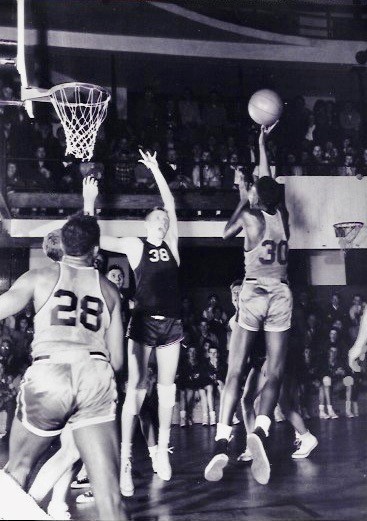 “Saginaw High easily defeated the Arthur Hill High school basketball players … in the first game of the interscholastic series,” stated the Saginaw Daily News, “the final score standing 60 to 17. … (Bill) Steckert contributed 12 field baskets for the winners. … (Leo) Vondette starred for the losers.”
“Saginaw High easily defeated the Arthur Hill High school basketball players … in the first game of the interscholastic series,” stated the Saginaw Daily News, “the final score standing 60 to 17. … (Bill) Steckert contributed 12 field baskets for the winners. … (Leo) Vondette starred for the losers.”
Perhaps it was a typo – it’s impossible to know – but the final score differed in the 1911 Saginaw yearbook – “The Aurora” – when published in the spring. “Before a large crowd of enthusiastic fans, Arthur Hill was decisively defeated in the local gym, the final count being 69 to 17, with the East Siders on the heavy end.”
The author concluded with flair and flourish: “Steckert starred for Saginaw, getting 24 points to his credit, while Vondette was the celestial light for the vanquished quintet. Dancing was enjoyed after the game.”
A week later, the Saginaw girls basketball team opened its season against the west siders. According to the yearbook, “Saginaw out-played Arthur Hill and defeated them by the score of 41-4.” The newspaper credited Leona Buck as the leading scorer, with a phenomenal 29 points.
The Inevitable Finale
The doors open at 3 p.m. for the 2024 festivities at The Dow next Friday. Fittingly, the Saginaw girls team will tip off the action on the court at 5 o’clock. The girls programs already have consolidated, and the Phoenix of Saginaw United will face Flint Carman-Ainsworth – a school that consolidated in 1986. The Hill and High contest is scheduled for 7 p.m.
“It’s really going to be a big deal,” said Slaggert, thrilled by the prospect. “Saginaw’s going all out for this. They’re trying to do it up in style.”
The wrap-up comes a decade after what, initially, looked like the end.
On Feb. 15, 2014, Detroit Free Press sportswriter Mick McCabe wrote about the expected unification.
“Saginaw and Saginaw Arthur Hill likely met for the last time ever in the regular season Friday,” he wrote. Saginaw had just knocked off the Lumberjacks, the No. 2 team in McCabe’s weekly ranking of the state’s top teams.
“The Saginaw-Arthur Hill basketball rivalry is the best in the state, so you shouldn’t be surprised when the underdog wins. But Saginaw (11-6) was coming off consecutive losses to Midland and Midland Dow for maybe the first time ever.”
The school district was expected to announce the closure of Saginaw High that following Monday, merging its students into Arthur Hill. The move would mean a new school name, new school colors, and a new nickname.
Like many urban centers across the country, outbound migration of both jobs and people, combined with plunging birth rates, had altered the demographics of cities, and the education landscape.
“In just five decades, the city's population dropped from nearly 100,000 in the 1960s to fewer than 52,000 by the 2010 census,” stated the Saginaw News in 2014. “To say it another way, Saginaw lost 48 percent of its residents during the last 50 years.”
McCabe cut to what that meant to enrollment numbers at the two schools: “In 1987, Saginaw High had over 1,800 students; it is now down to about 600. Arthur Hill had 2,395 students in ’85; it now has 973.”
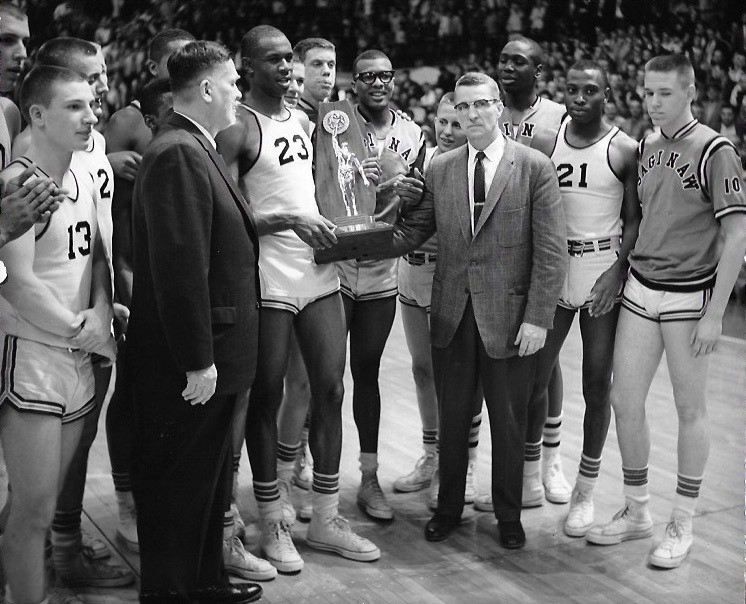 Despite the defeat, McCabe predicted Arthur Hill to be among the final four Class A teams still standing that season when the annual MHSAA Tournament shifted to Michigan State’s Breslin Center. But in the craziness of March, the Trojans again took down Arthur Hill in the Districts, 53-51.
Despite the defeat, McCabe predicted Arthur Hill to be among the final four Class A teams still standing that season when the annual MHSAA Tournament shifted to Michigan State’s Breslin Center. But in the craziness of March, the Trojans again took down Arthur Hill in the Districts, 53-51.
Adding to the madness, the expected consolidation didn’t happen. A recommendation by a Saginaw interim superintendent to close Saginaw High found no school board support.
With the potential consolidation still hovering, one year later sportswriter Bill Khan recalled other recent departures from Michigan’s classic basketball landscape in an article for the StateChamps! Sports Network:
“The Saginaw-Arthur Hill rivalry is at risk of going the way of other great urban rivalries – such as Flint Central-Flint Northern, Pontiac Central-Pontiac Northern, Lapeer East-Lapeer West, Detroit Cooley-Detroit Southwestern, Detroit Mackenzie-Detroit Redford, Detroit Kettering-Detroit Northeastern, Detroit Miller-Detroit Northern and Detroit Southeastern-Detroit Eastern, that have ended in years past due to school closures and consolidations.”
Arthur Hill downed the Trojans twice during the 2014-15 regular season league action, and again in postseason District play, before finishing the year as Class A runner-up, and the holding pattern of the planned school merger continued.
Enrollment numbers continued to drop at both schools and after much community and school board debate, construction on a brand-new five-story Saginaw United High School began in 2022.
A Celebration of Statistics
The state basketball tournament kicked off in 1917. Over 107 years, on only two occasions – in 1943 during World War II, and in 2020, due to COVID-19 – the tournament was not completed.
Slaggert breaks down the City of Saginaw School District’s incredible basketball history in a quick series of numbers.
“47-36-18-8,” said Slaggert, stressing a bullet point of a well-rehearsed pitch, breaking out the incredible success of the two schools come tournament time.
“During those 105 tournaments, 47 times, Saginaw High (starting in 1919) or Arthur Hill (beginning in 1930) made it into the state Quarterfinals – the final eight.
“That’s almost half of the 105 possible years. And in most cases throughout that rivalry, they would have played each other in the Districts. So how many more times would they have made it if they were coming in different brackets or different directions? “
To take that further, he noted, 36 times one of those teams made it into the final four. On 18 occasions, one of the two schools reached the state title game, and on eight occasions, they emerged as MHSAA state champions.
Six of those titles were won by Saginaw High (1942, 1962, 1996, 2007,2008, 2012). Arthur Hill’s championships were won in 1944 and 2006.
“That's a pretty incredible stat for two schools in the same town, don’t you think?” Slaggert asked.
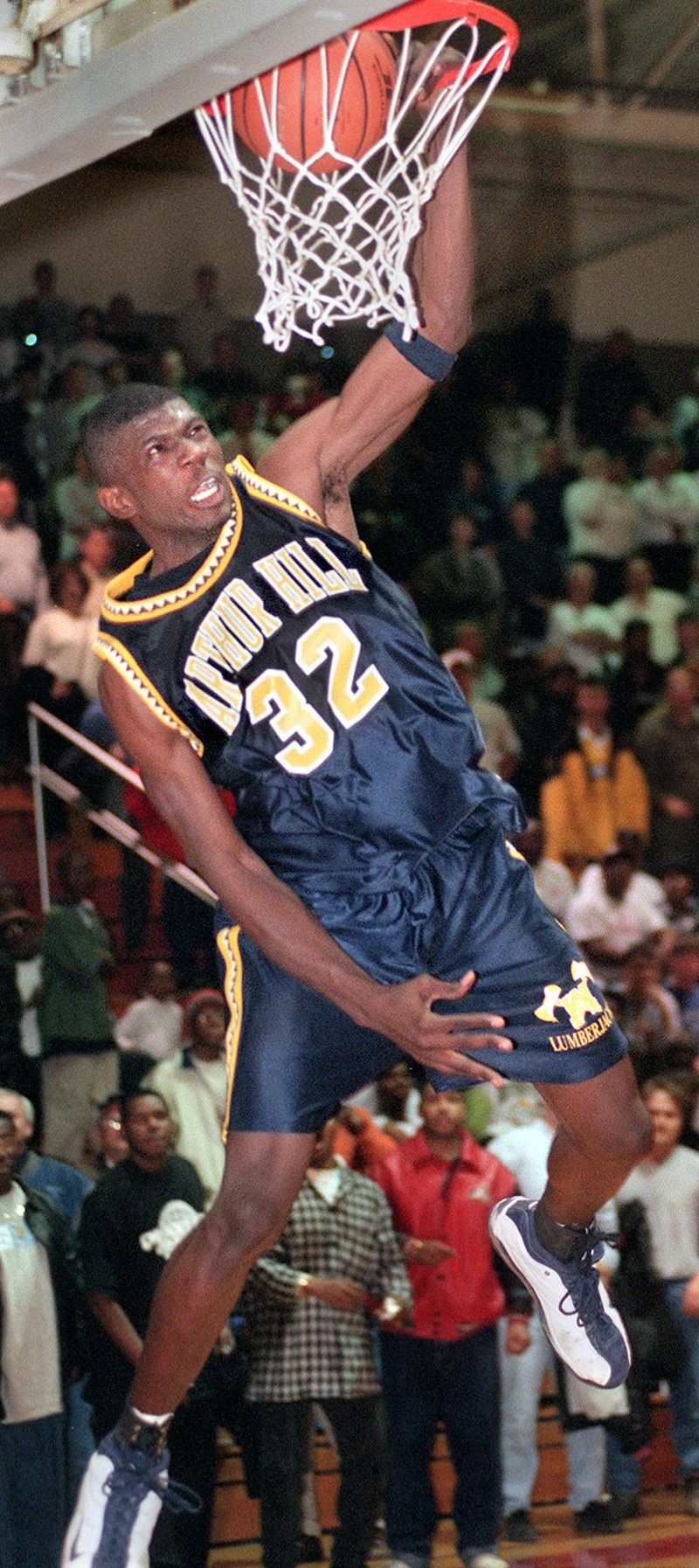 That history also points out another Slaggert challenge. As illustrated, come March the schools could, in theory, bump into each other one more time come the postseason. This year, the teams are in different Districts, and could potentially cross paths in an MHSAA Regional.
That history also points out another Slaggert challenge. As illustrated, come March the schools could, in theory, bump into each other one more time come the postseason. This year, the teams are in different Districts, and could potentially cross paths in an MHSAA Regional.
A Parade of All-Staters
Between 1938 and 2023, a combined total of 106 players from the two schools – 10 or more in each decade from the 1940s to the 2010s – have earned all-state basketball honors from The Associated Press and/or one or more of the Detroit newspapers: the Free Press, News or Times.
Since the introduction of Michigan’s Mr. Basketball award in 1981, honoring the best-of-the-best from the state’s top high school seniors, 10 players from the two schools have landed among the top five in voting: Eric Davis (AH –‘15), Maurice Jones (AH –‘10), Draymond Green (S –‘08), Dar Tucker (AH –‘07), Anthony Roberson (S –‘02), Eugene Seals (S –’00, and head coach of the United girls basketball team), Jason Richardson (AH-‘99), Jessie Drain (S –‘91) and Daryl Reed (S –‘87). Richardson won the award. Davis, Green, Tucker, Roberson, and Seals all finished second in the annual voting.
Tony Smith (S -‘74), Craig Dill (AH -‘63), Ernie Thompson (S -‘62), Webster Kirksey (S -‘51), Dick Rifenburg (AH -‘44), and Larry Savage (S -‘42) were all honored by the Basketball Coaches Association of Michigan with their Retro Mr. Basketball Award when the organization sought to honor the great seniors in Michigan high school basketball from the years 1920 through 1980. Seven others – James Koger (S -‘79), Lovell Humes (S – ’63), Bill Agre (AH -‘47), Gene Glick (AH -’46), Jack Mott (AH -’45), Eddie Johnson (S – ’43) and Stanley Paskiewicz (S -’38) – were among the candidates for that award.
Based on research by Orchard Lake St. Mary’s Robin Goddard, Saginaw High is likely the state’s winningest basketball program, trailed by Benton Harbor, Kalamazoo Central and Orchard Lake St. Mary’s.
Initially, Saginaw dominated the crosstown series with the Lumberjacks. But by the 1920s Arthur Hill overcame the deficit, and by the mid-1950s the Hill had opened a wide 25-game lead in wins versus losses. But by 1975, the gap had narrowed with the Trojans just six games back in the series. And yet, the exact status of the rivalry is still unknown, as the capture of game scores is spotty going forward.
The digging to capture those missing scores continues, as does the race to game day.
Slaggert has committed to printing 1,000 copies of his book. His challenge to date has been selling copies of something that does not yet, physically, exist. As it stands, currently there are 772 pages in the book. It includes a mind-blowing 800+ photos dating as far back as 1905. The sale price is fixed at $40. That currently means the production cost per copy exceeds the retail price, so Slaggert continues to chase sponsorships to defray the printing expense.
“It’s a non-profit effort,” he noted. “If there are any profits, they go to scholarships for the new high school. All money is run through the Saginaw Community Foundation,” which makes sponsorships tax-deductible.
His favorite memory from the series is his last victory as an Arthur Hill coach. It comes from 2001.
“Saginaw High defeated us 90-37 in the second game of that season and finished with a 17-5 season record that year,” he retold. “We had a modest 10-10 season record heading into the Districts but showed lots of improvement through the season. We met again in the District Finals. Saginaw High was led by Anthony Roberson, LaMarr Woodley, Michael Thomas and Tanoris Shepard and was ranked seventh in the state. In front of a sold-out Heritage High School crowd, our kids played their hearts out and, led by Devaundre Whitson, Omar Linder, and Freddy Jackson, pulled out a 68-66 overtime win! (It’s) my greatest thrill in coaching, and most of the old-timers say it’s the greatest upset in the rivalry.”
Slaggert retired from coaching after that season, and in the years to follow, found a desire to record the history of the series.
“I have nine living coaches from Saginaw and Arthur Hill that have written a chapter for me. I have eight others that I've written on Larry Laeding, Chuck Fowler, and different coaches that are deceased,” he said. “My intent is to give something back to my community. I didn’t do this for money. I wanted this story to be passed down to future generations – people 100 years from now about Jason Richardson, Draymond Green, Ernie Thompson, Craig Dill, and all the great ones.
“It’s a labor of love for me, I’ve really enjoyed it.”
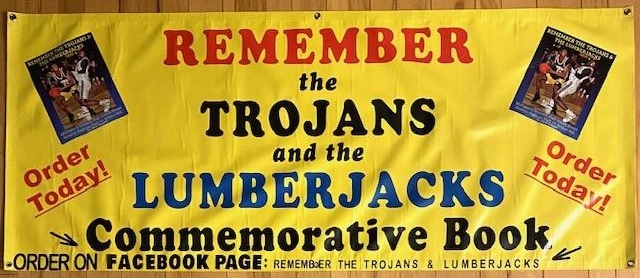 To order Slaggert's book, click for the Facebook link or visit the Saginaw Community Foundation website, click "Give Now" and select the book title as Fund. Cost is $40 with an option including shipping for $52.
To order Slaggert's book, click for the Facebook link or visit the Saginaw Community Foundation website, click "Give Now" and select the book title as Fund. Cost is $40 with an option including shipping for $52.
PHOTOS (Top) Saginaw Eugene Seals drives against Arthur Hill’s Jason Richardson – with coach Marshall Thomas in the background – during a sold-out 1999 game at the Saginaw Civic Center. (2) Arthur Hill’s Ernie Thompson and coach Larry Laeding accept the 1962 Class A championship trophy. (3) Saginaw High’s Webster Kirksey (30) puts up a shot; he graduated in 1951. (4) Richard dunks at the final buzzer as Arthur Hill downs top-ranked Flint Northwestern in a 1999 Class A Regional matchup. (Photos collected by Dave Slaggert. Top photo courtesy of Saginaw News/MLive.)

